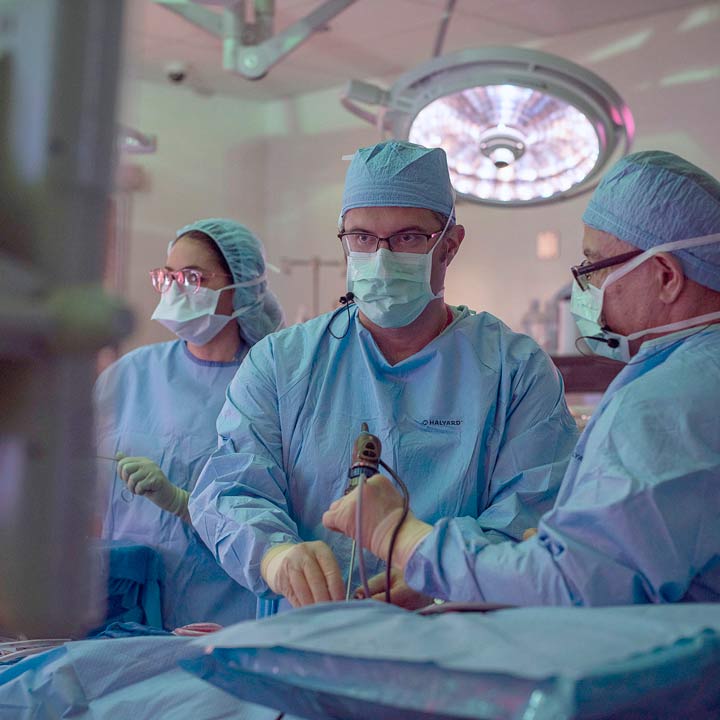 A collaborative surgical approach used at The Ohio State University Wexner Medical Center helps enhance safety and outcomes among people with acoustic neuromas or other skull-base conditions.
A collaborative surgical approach used at The Ohio State University Wexner Medical Center helps enhance safety and outcomes among people with acoustic neuromas or other skull-base conditions.
Instead of managing such cases individually, surgeons from the Department of Otolaryngology – Head and Neck Surgery and the Department of Neurosurgery team up to plan and perform lateral skull-base surgery.
By operating in pairs, these surgeons can better optimize cranial nerve preservation — reducing the risk of complications like facial weakness or paralysis.
Consensus-driven treatment planning
When a neurotologist or neurosurgeon from either department sees a new patient who may need lateral skull-base surgery, they don’t hesitate to call each other to establish a solid treatment plan.
“Even though we regularly operate together, our collaboration begins outside of the OR,” says neurosurgeon Daniel Prevedello, MD, MBA, director of the Skull Base and Pituitary Surgery programs at The Ohio State University Comprehensive Cancer Center – Arthur G. James Cancer Hospital and Richard J. Solove Research Institute. “If I have a patient with disease around the temporal bone, I automatically bring in one of the neurotologists and vice versa. We jointly see patients on Tuesdays, and together we discuss the risks and benefits of various treatments, including observation and surgery.”
In addition to Dr. Prevedello, the neurosurgery team includes Russell Lonser, MD, and Kyle Wu, MD. Their neurotology colleagues include Oliver Adunka, MD, MBA; Edward Dodson, MD; Yin Ren, MD, PhD; and Desi Schoo, MD. Together, these specialists work together to treat conditions such as cerebrospinal fluid leaks, chondrosarcomas, chordomas, encephaloceles, meningiomas, paragangliomas and superior canal dehiscence syndrome.
Two sets of eyes, two pairs of hands and twice the expertise
In cases where surgery is the ideal option, both specialists decide on the best technique for each patient.
“There are different ways to approach skull-base tumors and we offer them all,” says Dr. Adunka, director of the Division of Otology, Neurotology and Cranial Base Surgery. “Because we have experience performing translabyrinthine, middle fossa and retrosigmoid approaches, we can choose the one that is likely to produce the best outcome instead of preselecting a procedure.”
Dr. Prevedello says once surgery is underway, having another surgeon alongside him is like flying a plane with a co-pilot. Among the surgeons, he and Dr. Adunka are one of the most established duos; they’ve worked together for nearly 10 years and share an exceptional level of familiarity and trust.
Having mastered the bony anatomy of the skull base, the neurotologist starts by performing any drilling required to expose the inner portions of the ear. This gives the neurosurgery team access to the deeper areas within the skull, brain and brainstem.
“Acoustic neuromas and other skull-base tumors are difficult to resect, and surgery can have high rates of incidental facial palsy and hearing loss,” Dr. Prevedello says. “But with two of us in the OR, we can double-check with each other before making certain movements and we provide each other constant feedback.”
These partnerships are not reserved for the most complex cases. The surgeons work in tandem on every lateral skull-base procedure, even those that are seemingly straightforward.
Comprehensive, well-coordinated care
Because many of their patients need other treatments in addition to skull-base surgery, the neurotologists and neurosurgeons often collaborate with specialists outside of their core team.
“While our surgical approach certainly contributes to our excellent outcomes, that’s not the only factor,” Dr. Adunka says. “We’re also a high-volume academic medical center that offers any other services patients might need to overcome or live well with their condition.”
For example, people with neurofibromatosis type 2 can turn to Ohio State for any number of treatments. These range from skull-base surgery and facial reanimation surgery to radiation therapy, audiology services and cochlear implantation.
The neurotology and neurosurgery teams also collaborate on research related to skull-base tumors. Together with experts from Ohio State’s Department of Radiology and Department of Pathology they collect and study tumor specimens through an active tumor biobank.
With access to resources like these, the surgeons routinely lead novel research activities that may improve skull-base tumor diagnosis and treatment. As a group, they’re working on several active studies that aim to improve vestibular schwannoma and meningioma care. And they each contribute to the field (and the literature) individually, too. For example, Dr. Ren’s laboratory research focuses on identifying new biomarkers and treatments for difficult-to-treat skull-base disorders.
“With our breadth of services and depth of expertise, we can customize treatment plans for every patient,” Dr. Prevedello says. “This leads to an exponential improvement in outcomes among the people who turn to us for care.”
